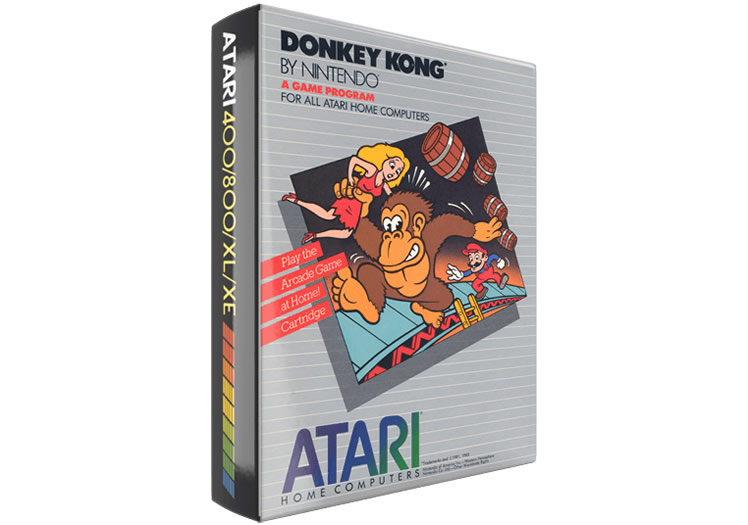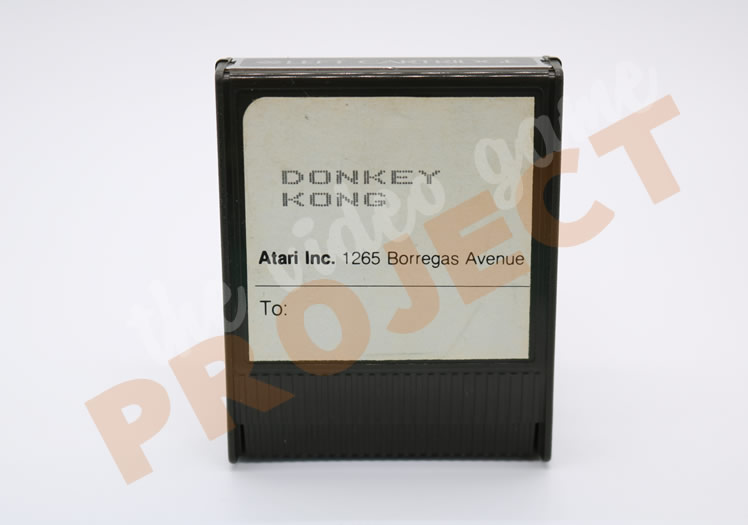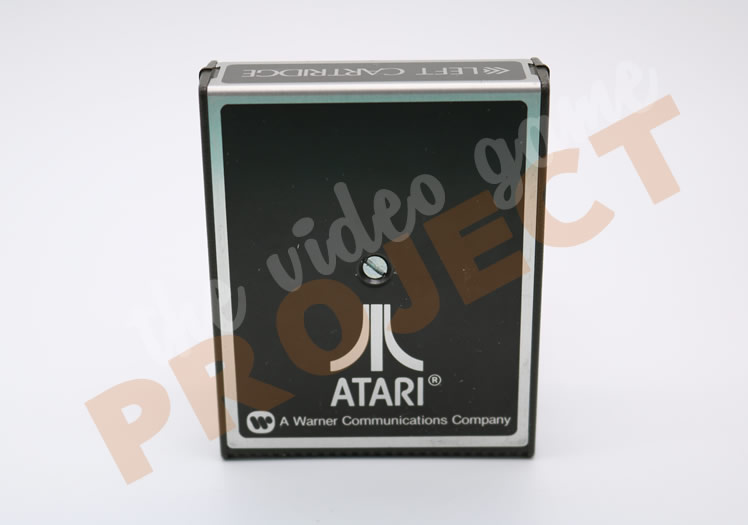The Video Game Project
A Closer Look At The Prototypes That Became Your Favourite Games!
Donkey Kong Atari 800 Prototype
 Donkey Kong is an arcade game that was released to critical acclaim by Nintendo in 1981. It is one of the most important games from the golden age of the arcade and celebrated the world over as one of the most popular arcade games of all time. Despite all this, Donkey Kong had a less that straight forward path during it's development.
Donkey Kong is an arcade game that was released to critical acclaim by Nintendo in 1981. It is one of the most important games from the golden age of the arcade and celebrated the world over as one of the most popular arcade games of all time. Despite all this, Donkey Kong had a less that straight forward path during it's development.
In the later part of 1980 and early 1981, Nintendo attempted to expand their companyies dominance in the video game market by trying to break into North America. Ultimattely they failed. Radar Scope, a game that was relatively successful in thier home country of Japan just didn't have as much appeal in the U.S. Having already been built and shipped, Nintendo were left with a large number of unsold machines, so company president Hiroshi Yamauchi thought of simply converting them into something new. He approached a young industrial designer named Shigeru Miyamoto, who had been working for Nintendo since 1977, to see if he could design such a replacement. Miyamoto jumped at the opportunity and Yamauchi enlisted Nintendo's head engineer, Gunpei Yokoi, to help and supervise the project. With a budget set at roughly $100,000, develpment of the game began.
At the time, Nintendo was also pursuing a license to make a game based on the Popeye comic strip. They presumed that this wouldn't be an issue as they had previously held the licence to make Popeye playing cards. When their license attempt failed, Nintendo had to switch it up and took the opportunity to create new characters that could then be marketed and used in later games. Miyamoto came up with many characters and plot concepts, but he eventually settled on a love triangle between a gorilla, a carpenter, and a girlfriend that mirrors the rivalry between Bluto and Popeye for Olive Oyl. The gorilla or ape, an ape, Miyamoto decided, was "nothing too evil or repulsive". He would be the pet of the main character, "a funny, hang-loose kind of guy." Miyamoto has also named "Beauty and the Beast" and the 1933 film King Kong as influences. Although its origin as a comic strip license played a major part, Donkey Kong marked the first time that the storyline for a video game preceded the game's programming rather than simply being appended as an afterthought.
Yamauchi wanted primarily to target the North American market, so he mandated that the game be given an English title, though many of their games to this point had English titles anyway. Miyamoto decided to name the game for the ape, whom he felt was the strongest character. The story of how Miyamoto came up with the name "Donkey Kong" varies. A false urban myth says that the name was originally meant to be "Monkey Kong", but was misspelled or misinterpreted due to a blurred fax or bad telephone connection. Another, more credible story claims Miyamoto looked in a Japanese-English dictionary for something that would mean "stubborn gorilla", or that "Donkey" was meant to convey "silly" or "stubborn"; "Kong" was common Japanese slang for "gorilla". A rival claim is that he worked with Nintendo's export manager to come up with the title, and that "Donkey" was meant to represent "stupid and goofy". In the end, Miyamoto stated that he thought the name would convey the thought of a "stupid ape".
Miyamoto himself had high hopes for his new project. He lacked the technical skills to program it alone, so instead came up with concepts and consulted technicians to see if they were possible. He wanted to make the characters different sizes, move in different manners and react in various ways. Yokoi thought Miyamoto's original design was too complex, though he had some difficult suggestions himself, such as using see-saws to catapult the hero across the screen (eventually found too hard to program, though a similar concept would appear in the aforementioned Popeye arcade game). Miyamoto then thought of using sloped platforms, barrels and ladders. When he specified that the game would have multiple stages, the four-man programming team complained that he was essentially asking them to make the game repeatedly. Nevertheless, they followed Miyamoto's design, creating a total of approximately 20 kilobytes of content. Yukio Kaneoka composed a simple soundtrack to serve as background music for the levels and story events.
The circuit board of Radar Scope was restructured for Donkey Kong. The Radar Scope hardware, originally inspired by the Namco Galaxian hardware, was designed for a large number of enemies moving around at high speeds, which Donkey Kong did not require, so the development team removed unnecessary functions and reduced the scale of the circuit board. While the gameplay and graphics were reworked for updated ROM chips, the existing CPU, sound hardware and monitor were left intact. The character set, scoreboard, upper HUD display and font are almost identical to Radar Scope, with palette differences. The Donkey Kong hardware had the memory capacity for displaying 128 foreground sprites at 16x16 pixels each and 256 background tiles at 8x8 pixels each. Mario and all moving objects used single sprites, the taller Pauline used two sprites, and the larger Donkey Kong used six sprites.
After seeing the game, Hiroshi Yamauchi felt the game was going to sell well and called Minoru Arakawa, head of Nintendo's operations in the US, to tell him. Nintendo's American distributors, Ron Judy and Al Stone, brought Arakawa to a lawyer named Howard Lincoln to secure a trademark. The game was sent to Nintendo of America for testing. The sales manager disliked it for being too different from the maze and shooter games common at the time, and Judy and Lincoln expressed reservations over the strange title. Still, Arakawa adamantly believed that it would be a big hit. American staff began translating the storyline for the cabinet art and naming the characters. They chose "Pauline" for the Lady, after Polly James, wife of Nintendo's Redmond, Washington, warehouse manager, Don James. The name of "Jumpman", a name originally chosen for its similarity to the popular brands Walkman and Pac-Man, was eventually changed to "Mario" in likeness of Mario Segale, the landlord of the original office space of Nintendo of America. These character names were printed on the American cabinet art and used in promotional materials. Donkey Kong was ready for release.
Stone and Judy convinced the managers of two bars in Seattle, Washington, to set up Donkey Kong machines. The managers initially showed reluctance, but when they saw sales of $30 a day—or 120 plays—for a week straight, they requested more units. In their Redmond headquarters, a skeleton crew composed of Arakawa, his wife Yoko, James, Judy, Phillips and Stone set about gutting 2,000 surplus Radar Scope machines and converting them with Donkey Kong motherboards and power supplies from Japan. The game officially went on sale in July 1981 and the rest as they say was history!
Donkey Kong went from success to success and Nintendo were quickly inundated with requests to port the to the home console market. Taito offered a considerable sum to buy all rights to Donkey Kong, but Nintendo turned them down after three days of discussion within the company. Rivals Coleco and Atari approached Nintendo in Japan and the United States respectively. In the end, Yamauchi granted Coleco exclusive console and tabletop rights to Donkey Kong because he felt that "It was the hungriest company". In addition, Arakawa felt that as a more established company in the US, Coleco could better handle marketing. In return, Nintendo would receive an undisclosed lump sum plus $1.40 per game cartridge sold and $1 per tabletop unit. On December 24, 1981, Howard Lincoln drafted the contract. He included language that Coleco would be held liable for anything on the game cartridge, an unusual clause for a licensing agreement. Arakawa signed the document the next day, and, on February 1, 1982, Yamauchi persuaded the Coleco representative in Japan to sign without running the document by the company's lawyers.
Coleco did not offer the game cartridge stand-alone; instead, they bundled it with their ColecoVision, which went on sale in August 1982. Six months later, Coleco offered Atari 2600 and Intellivision versions, too. Notably, they did not port it to the Atari 5200, a system comparable to their own. Coleco's sales doubled to $500 million and their earnings quadrupled to $40 million. In fact, Coleco's console versions of Donkey Kong sold six million cartridges in total, grossing over $153 million, and earning Nintendo over $5 million in royalties. Coleco also released stand-alone Mini-Arcade tabletop versions of Donkey Kong, which, along with Pac-Man, Galaxian, and Frogger, sold three million units combined. Meanwhile, Atari got the license for computer versions of Donkey Kong and released it for the Atari 400/800.

Proto - Front
